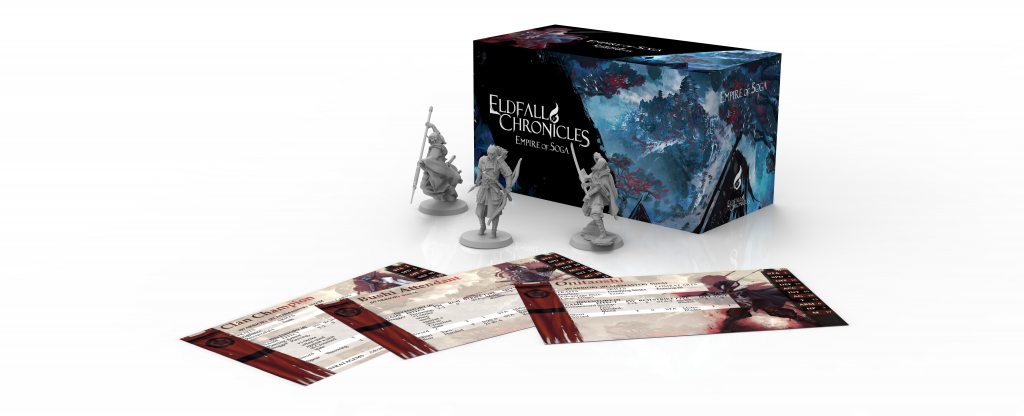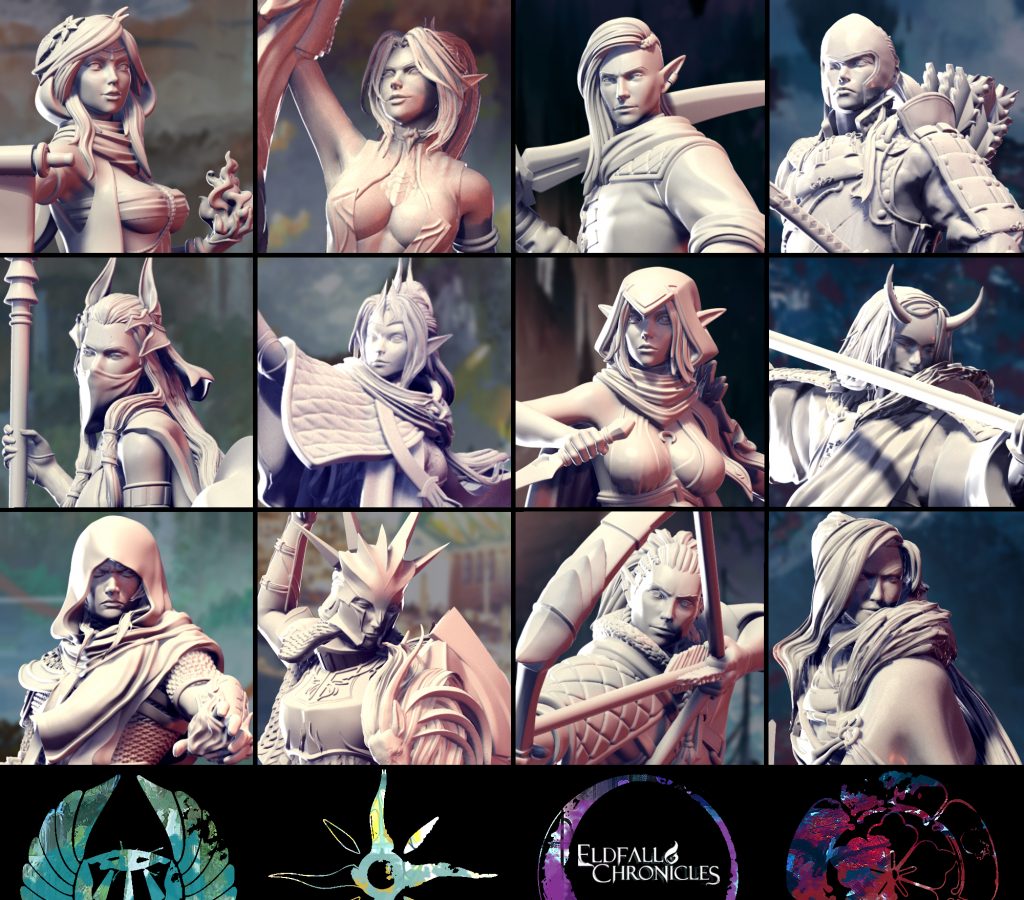How Does Core Gameplay Work In Eldfall Chronicles?
February 16, 2021 by brennon
Building on our series of articles looking at the world of Eldfall Chronicles which is coming to Kickstarter soon, we got the team behind the game to take us through the basic gameplay concepts that you'll come up against when diving into the game.
Check Out More From Eldfall Chronicles
If you're interested in the game then make sure to check out the links up above where we're talking about Lore and more. Plus, you can also dive in and check them out on social media on Facebook and Instagram too.
Getting Started With Eldfall Chronicles
When starting a game, the players first have to decide on a quest. These give the game a particular atmosphere and a purpose whilst also offering diversity, compel you to adopt different strategies in different situations. Quests are essentially missions with objectives. Some are more suited for competitive play, while others offer a more lore-driven and adventurous experience.
As an aside to this core gameplay loop, one of our main objectives for the game is to implement an engaging “AI” system, allowing the players to face a quest and take on a third-party of autonomous models, be it hostile beasts or peoples. To summarise it briefly, the system dictates the behaviour of a model in relation to the circumstances. There is an option to manually command the creatures and hostiles as well if you prefer.
After selecting a quest, you then have to select your faction and outfit your party. As a commander, you will have a limited number of resources for recruiting and outfitting your party. At this point you have to keep in mind they are going on specific daring adventures and clandestine pursuits, achievable only by smaller, well-trained groups of braves. Each faction is different – and tends to focus on its own unique playstyle - which also means it has its own selection of unique models. Each faction also has distinct upgrades through which can modify your models before departing.
At first, each faction will be presented with three starter models. However, this is only the beginning. We intend to continuously expand the game with additional unique models, which will allow you a wider selection to tailor to your preferences and form larger parties in the future. Some of the models will also function as mercenaries, who can be recruited into every faction.
The small number of adventurers you command does not make the situation any less intense. On the contrary! Each of the models in a party is different and every one of them can be considered as an individual, who has multiple skills, weapons and abilities, that make them distinct. Each is an indispensable party member, bringing unique elements to the table. Each one is suited to different tasks, excelling in different situations and allowing different approaches to winning and problem-solving. In this case, a smaller number of models under your command allows you to know them better and guide them more efficiently, mimicking an actual skirmish or adventure scenario.
Arguably, the best way to command a party might be to seek synergies amongst your adventurers while considering their strengths and weaknesses. This is very much the case with an individual in a party also acting as the leader, who can, through unique Stratagem abilities, bolster allied models or undermine the enemy.
The game keeps both (or all) players constantly engaged: while one player performs their Active turn, the other player performs their Reactive turn, allowing them to respond to the other player’s movements.
Core Gameplay Moments In Eldfall Chronicles
Looking at the general gameplay; at the beginning of each turn, each model on the field receives a number of Activation Points, corresponding to their Stamina. The player whose turn it is may conduct their Active turn. During this, their opponent, the Reactive player, performs their Reactive turn, reacting against the Activations of the other player’s models. Performing activations and reacting against them is one of the main components of the game-flow which keeps everyone engaged.
Activation Points affect your manoeuvres and the way you strategise. The Active player may activate a model by spending one of its Activation points. That model may then move and try to perform an action. However, this may get complicated if an opposing "reactive" model sees the activated model during its movement. The reactive model can choose to react against it by spending one of its own Activation points and declaring an action it will try to perform (commonly being an attack or dodge). The activated model will then have to decide whether to deal with the reacting model and adjust its action or to continue with its original intent.
To clarify, every turn, each model on the field commonly receives two Activation points (as most models have a Stamina value of two). This means that each model may activate (move and perform actions) twice during its active turn and react twice against enemy models (with actions) during its reactive turn.
In the case where two models attack one another, a Confrontation occurs. This means that both models will attempt to perform an attack but only the one with the highest successful roll result (on a D20) will win the confrontation, avoid the incoming blows and deliver one or multiple hits to the opponent.
These activations and reactions may seem dry in their concept. However, every model can behave differently – their skills and abilities vary greatly. Everything you want to do in the game is largely dependent upon the models you command. For example, some models will excel at melee combat, while others will prefer to assail the enemy from afar. Some are good at running, while others are slow. Some are well protected while others need to be more careful. Some have skills that can turn the tide of battle.
The realism of combat is of great importance to us. Therefore, we wanted to make combat dynamic and fast-paced, but still intricate, in order to make each model different in use. Moreover, we wanted to create a game where luck is not an essential part of winning. We hope the game will challenge your approach to leadership and tactic use. On the other hand, we hope it gets everyone around the table to have lots of fun!
Are you tempted by this early look at gameplay for Eldfall Chronicles?
"Performing activations and reacting against them is one of the main components of the game-flow which keeps everyone engaged..."
Supported by (Turn Off)
Supported by (Turn Off)
"We hope the game will challenge your approach to leadership and tactic use..."
Supported by (Turn Off)


















































































Can someone explain what a taskmage is?
I think they would be classed as a battle wizard I most games?
Good to know, this kind of tricky names are quite difficult for non native speakers :). Thanks mate!!
No problem mate.?
I’ve been watching this project for a bit and am looking forward to the KS. Thanks for the look ahead at the core concepts. I like the idea of “neutral” third parties moving about especially if the game is going to be quest based. That will hopefully add a nice dynamic where players will need to consider the objective, their opponent and the environment/AI.
Is the intent to have co-op or partial co-op missions or will objectives always be in direct conflict?
There will be the ability to go down the co-op/solo route I believe aye
I’m tempted by the models. I’d really be in the market for a good elven range en par with the infinity offerings for sci-fi.
The rules don’t tell me a whole lot.I’ve grown weary of games where each player has a full “active turn”. That would depend on the options of the reactive player, I guess. Also d20 sounds to random for me, but that might be mitigated by abilities. So, I’ll keep an eye out for more information.
Fantasy adventuring against an IA I like
Sounds like a good game play of push an pull between side’s.